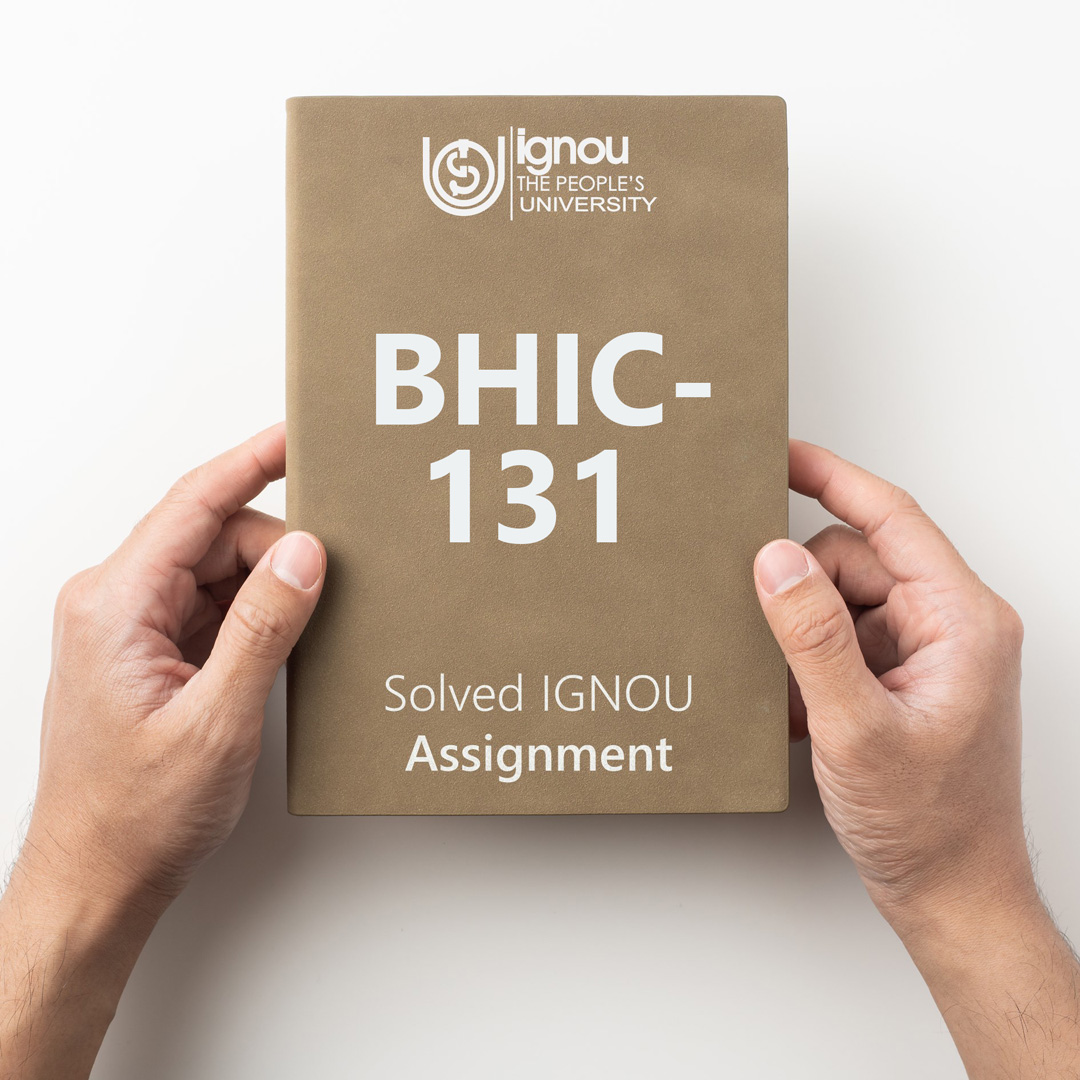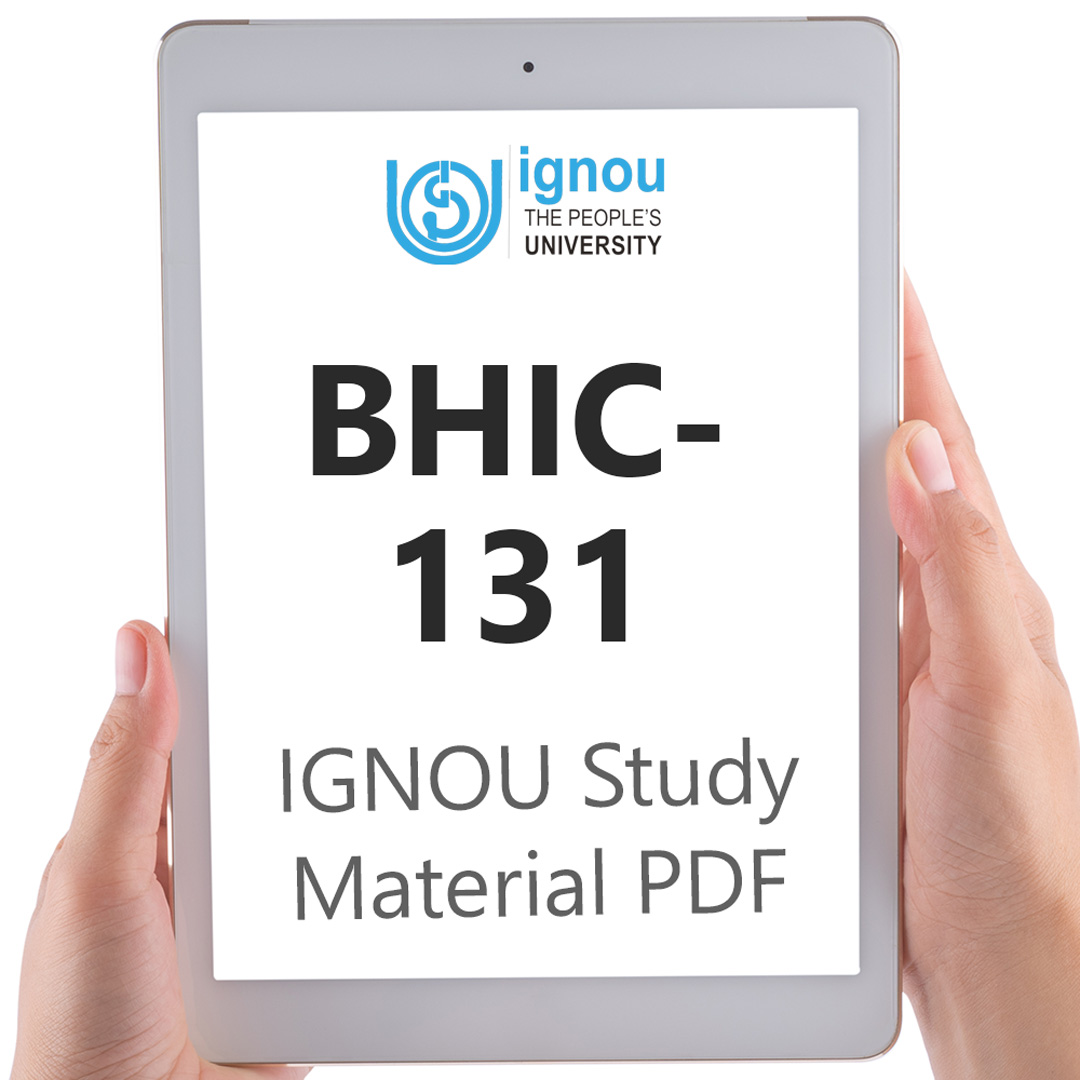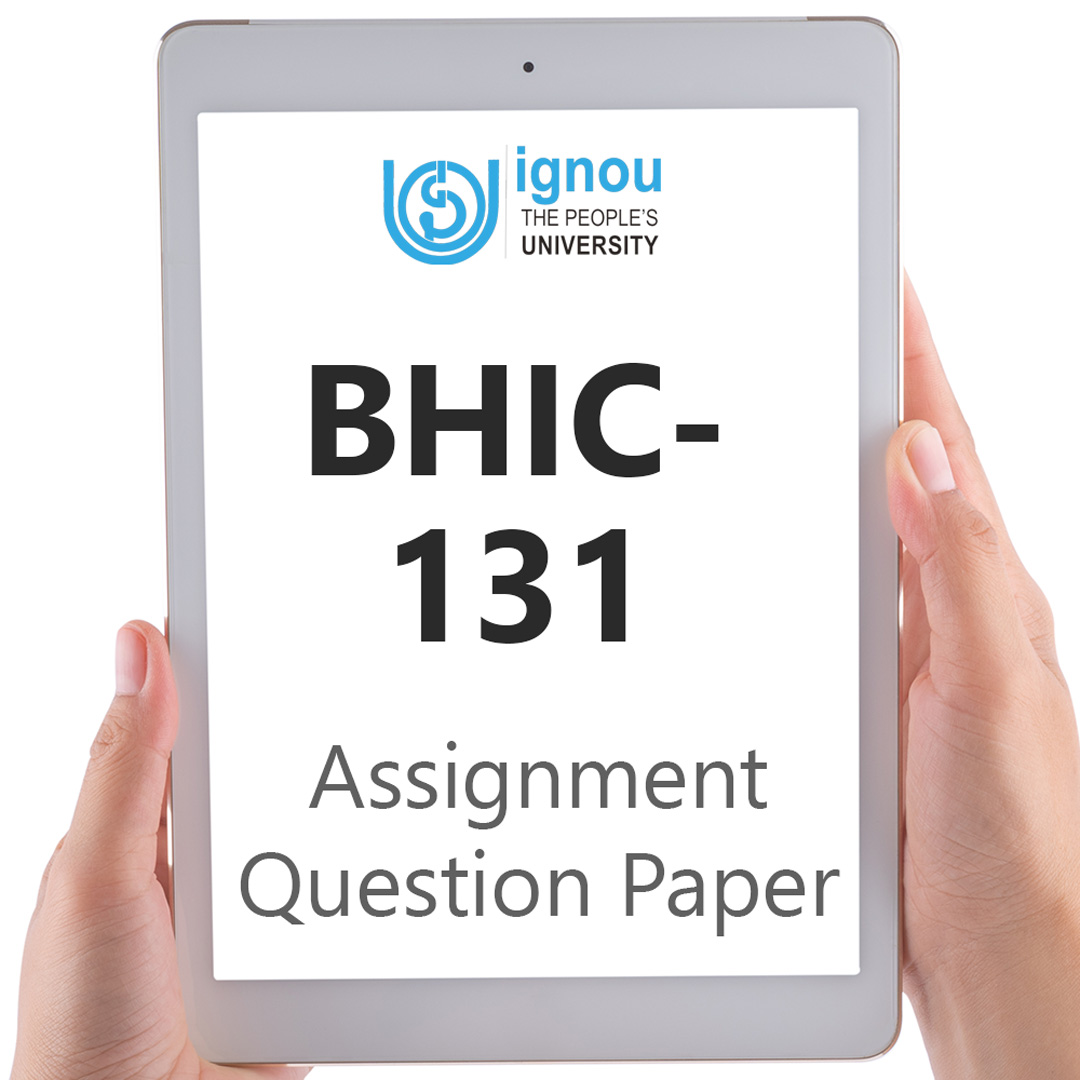If you are looking for BHIC-131 IGNOU Solved Assignment solution for the subject History of India from the Earliest Times upto c. 300 CE, you have come to the right place. BHIC-131 solution on this page applies to 2022-23 session students studying in BAG courses of IGNOU.
BHIC-131 Solved Assignment Solution by Gyaniversity
Assignment Code: BHIC-131/ASST/TMA/2022-23
Course Code: BHIC-131
Assignment Name: History of India from the Earliest Times up to C. 300 C.E.
Year: 2022-2023
Verification Status: Verified by Professor
There are three Sections in the Assignment. You have to answer all questions in the Sections.
Section-I
Answer the following in about 500 words each. 20x2
Q1) What is a literary source? Evaluate the relevance of Puranas and Sangam literature in the reconstruction of ancient Indian history.
Ans) The knowledge amassed in written forms known as literary texts explains the essence of ancient civilisation. Journals, letters, novels, and investigative reports are all used as sources for impressionistic, automated, and graphic compositions. Literature serves as a reminder of the social, political, economic, cultural, and religious activities of our ancestors. The majority of ancient writings are religious in nature. There is a vast amount of secular literature on arithmetic, science, and medicine in addition to religious material. During the ancient and mediaeval eras, there were a lot of well-educated people that travelled the world.
Puranas
Hindu writings in the Puranas subgenre are credited to Vyasa. The Gupta and post-Gupta periods are when they were produced. There are several Upapuranas and 18 Mahapuranas. Their content suggests that these were diverse, encyclopaedic publications by numerous authors covering a wide range of topics.
The Puranas are thought to cover the following five branches as its subject matter:
sarga (evolution of universe/creation of the world),
pratisarga (involution of universe/re-creation),
manvantara (recurring of time/periods of the various Manus),
vamsha (genealogical lists of gods, kings, and sages), and
vamshanucharita (an account of royal dynasties/life stories of some selected characters).
The Puranas provide important information for rewriting ancient Indian history. They shed information on dynastic genealogy and political history. The history of dynasties including the Haryankas, Shishunagas, Nandas, Mauryas, Sungas, Kanvas, and Andhras is extensively covered. Also mentioned are a few monarchs whose names end in "naga," who are said to have ruled over northern and central India. It's interesting that we have no more information about these kings. The Puranas may have been put together by the 4th to 6th centuries CE, according to the dynastic lists, which terminate with the Guptas.
Sangam Literature
The corpus of Sangam literature contains the earliest Tamil texts. This is the creation of poets who wrote both brief and lengthy poetry over the course of three to four centuries, receiving the support of chiefs and monarchs. They met in institutions known as Sangam colleges, and the literature created in these institutions is known as Sangam literature. Three Sangams were held, the first and last at Madurai and the second in Kapatapuram. However, there is substantial controversy surrounding the veracity of these gatherings.
The poems, which total 30,000 lines, are about love and battle. They were modelled after the bardic chants of the past and were first passed down orally for a considerable amount of time before being collected. They are not literary works of a religious nature. Teachers, businesspeople, tradespeople, carpenters, goldsmiths, blacksmiths, warriors, ministers, and even kings were among the poets' diverse backgrounds. They are a goldmine of knowledge about daily life in those periods because of their variety of themes and authors. They represent the best literature available.
Numerous thriving towns, including Kaveripattinam, are mentioned in the Sangam literature. They also mention the Yavanas arriving in their own boats, trading gold for pepper, and giving the locals alcohol and female slaves. Archaeology and testimonies from outsiders confirm the data provided by the Sangam literature on trade. Inscriptions also support the mention of various kings and historical occurrences.
Q2) What do you understand by archaeological excavation? What is the difference between archaeological exploration and excavation?
Ans) Surface investigations yield significant information that can aid in our ability to resolve particular historical mysteries. However, because their appearance on the surface is a result of actions that disturbed the initial deposition, the artefacts that have been taken from the surface do not belong in their rightful contexts. For instance, erosion from rain, tillage, animal burrowing, etc., may cause the archaeological deposit close to the surface to be moved. Therefore, archaeological excavation is done to gain a better understanding of a site or different cultural periods in their settings. It entails meticulously excavating a site in order to find material artefacts that were made and used by humans in the past.
The notion of stratigraphy is largely used in archaeological excavation to comprehend the chronological contexts of remains from various periods. The idea of stratigraphy is based on the stratification process and is derived from geology. In geology, sediments are accumulated very gradually in layers or strata, one on top of the other. In this procedure, the bottom layer or stratum is thought to have been laid down initially, followed by the subsequent strata that were laid down subsequently. The superimposition law governs this.
There are two main methods for excavating archaeological sites, depending on the objectives of the excavators:
Horizontal, and
Vertical.
In horizontal excavation, a sizable portion of the site is slowly excavated to reveal current structures and activity hubs of a specific phase. In contrast, small parts are excavated vertically, but they cut through the deposit to the level of the natural soil or when the site was originally occupied. Vertical excavations can thus offer a picture of the site's chronological changes over time.
Archaeological Exploration
Investigating archaeological sites based on their visible remains is known as archaeological exploration. Different techniques are employed for this. Aerial surveys were initially employed to locate high mounds, crop patterns, circles, etc. in order to locate the sites. These days, because to technological advancements, this is accomplished via geographic information systems and satellite pictures. Village-to-village survey is one such physical method, in which a team of archaeologists visits many communities and inquiries about old settlements or relics from the past.
Another approach involves breaking the entire region into a grid and further divisions as part of a thoroughly thought-out plan for a regional survey. All of the chosen grids or sampling units are meticulously searched by archaeologists for any artefacts or signs of human activity. The finding of new archaeological sites is made possible by such thorough explorations. In both expeditions and excavations, archaeologists employ a variety of scientific methodologies to get a deeper understanding of the past.
Without having to excavate the site, tools like ground penetrating radar, electric resistivity surveys, and magnetometry are employed in archaeological explorations to assist us understand the nature of sites and buried buildings or features. These methods are referred to be "non-destructive" because they don't in any way harm or change the archaeological record. The detection of hidden structures in recent years has greatly benefited by the use of the Light Detection and Ranging technique. In this technique, a plane flying over a survey area while carrying a laser scanner rapidly pulses laser beams toward the ground. It accurately depicts the ground in accordance with its elevation.
Section-II
Answer the following questions in about 250 words each. 10x3
Q1) Discuss the nature of economy and religion of the early Vedic period.
Ans) An earlier notion of Indo-Aryan migration into the Indian subcontinent from west Asia served as the foundation for earlier interpretations of the Early Vedic civilisation. The Vedic people are the migrants who are thought to have written the Vedas. This historical perspective holds that the Aryans arrived in India in many waves or stages.
Economy of the Early Vedic Period
Cattle-rearing was the primary vocation in the pastoral Early Vedic society. A pastoral society is more dependent on the richness of its animals than on agricultural output. People who live in locations where large-scale agriculture is not practical because of some environmental and, to some extent, cultural constraints, sometimes turn to pastoralist subsistence practises. There is a wealth of information about the significance of cattle in the Rigvedic hymns. There are numerous linguistic idioms that refer to cow in it. It served as a gauge of value and prosperity. Gomat was the name of a wealthy cattle owner.
Religion of the Early Vedic Period
The hymns of the Rigveda reflect the religious beliefs of the Vedic people. They revered the untamed natural forces that surrounded them, such as the wind, water, rain, thunder, and fire, and imbued nature with divinity, usually in the guise of male human beings. There were few female goddesses worshipped. Thus, the religion, which was a form of primordial animism, was a reflection of the patriarchal society. Vedic religion involved animal sacrifice. In order to obtain gifts from the gods, such as victory in battle, the acquisition of animals, sons, etc., sacrifices were made.
Q2) Explain the growth of Buddhism.
Ans) Gautama Buddha, whose parents had given him the name Siddhartha, is credited with founding Buddhism. His mother was Maya, the princess of the Koliya clan, and his father was Suddhodana, the Shakya clan's chief. He was created in the Nepalese tarai's Lumbini grove. Although there is some debate over the Buddha's birthdate, most experts agree that he was born around 566 BCE. Even though he lived a life of regal splendour, it did not capture his attention. According to tradition, seeing an old man, a sick person, a dead body, and an ascetic all at once had a profound impact on him. He was deeply affected by the suffering of human existence. Buddhism was well-liked by a wide range of individuals even during the lifetime of its founder.
The following reasons account for Buddhism's appeal to a significant segment of the population:
Buddhism was popularised by its emphasis on practical morals, straightforward philosophy, and a readily palatable answer to humanity's problems.
Many lay followers of Buddhism accepted it because of the principles of social equality outlined in the Buddhist scriptures.
Due to the esteem, they received in this religion, businesspeople like Anathapindika and courtesans like Amrapali adopted the religion.
The beliefs were explained in everyday language, which contributed to the religion's spread. This arose as a result of the Brahmanical religion's restriction on the use of Sanskrit, which was not the common language.
The kings' patronage was yet another key factor in the fast expansion of Buddhism.
Effective organisation of the propagation of Buddhism was made possible by the Sangha institution.
Q3) Describe the administrative machinery of the Maurya Empire.
Ans) Four provinces made up the Mauryan Empire, with Pataliputra serving as the imperial capital. The four regional capitals were Tosali, Ujjain in the west, Suvarnagiri, and Taxila, according to Ashokan edicts. Megasthenese claimed that the empire used 9,000 war elephants, 30,000 cavalry, and 600,000 infantrymen. A huge espionage network was in place to keep an eye on the officials and messengers as they travelled for the sake of internal and external security. To collect taxes from traders, farmers, herders, craftspeople, and other people, kings employed officials.
The king served as the focal point of the administrative organisation and was responsible for choosing ministers and senior officials. Voici how the administrative structure looked:
Below the King, who was helped by the Mantriparishad organisation, which also included Mantriparishad Adhyaksha, were the following:
Yuvaraj: The crown prince
Purohita: The chief priest
The Senapati: The commander in chief
Amatya: Civil servants and few other ministers.
The Mauryan Empire, according to scholars, was further divided into a number of departments with significant officials:
Revenue Department
Sannidhata: Chief treasury.
Samaharta: collector general of revenue.
Military Department
Megasthenese mentions a committee for coordinating military operations that had six subcommittees. Of these, the first oversaw the navy, the second oversaw transportation and supplies, the third oversaw foot soldiers, the fourth over horses, the fifth over chariots, and the sixth over elephants.
Espionage Department
Mahamatyapasarpa controlled Gudhapurushas.
Police Department
The jail was known as Bandhangara, and it was different from lock-up called Charaka. There were police headquarters in all principal centres.
Provincial and Local Administration
Pradeshika: modern district magistrates,
Sthanika: tax collecting officer under Pradeshika,
Durgapala: governor of fort,
Antapala: Governor of frontier,
Akshapatala: Accountant general,
Lipikaras: Scribes,
Gopas: responsible for accountants etc.
Municipal Administration
Nagaraka: in charge of city administration,
Sita-Adhyaksha: Supervisor of agriculture,
samastha-Adhyaksha: superintendent of market,
Navadhyaksha: Superintendent of ships,
Sulkaadhyaksha: Collector of tolls,
Lohadhyaksha: Superintendent of Iron,
Akaradhyaksha: Superintendent of mines and
Pauthavadhyaksha: Superintendent of weight and measures etc.
Section-III
Answer the following questions in about 100 words each. 6x5
Q1) Peninsular India
Ans) Peninsular India's borders are defined by the Deccan Plateau and the surrounding coastal plains. East and southern coastal plains are wide, while western coastal plains are narrow. In the area between Palghat and Bombay, they are the narrowest. Three main sections that roughly correlate to the states of Maharashtra, Andhra, and Karnataka make up the plateau. Northern Deccan plateau is one of the regions of Maharashtra. Since there are no other deep woods in the south outside the Western Ghats, it must have been possible for cultural influences from the Deccan to spread there. Maharashtra and Andhra Pradesh appear to share a natural border because fertile black soil is distributed along the border. One finds Telangana's red dirt over the border, which is unable to absorb rainwater.
Q2) Neolithic Culture of Kashmir Valley
Ans) By around 2500 BCE, village communities started to form in the Kashmir valley. The Neolithic civilisation of this area has been significantly illuminated by excavations at Burzahom and Gufkral. This area's Neolithic stage has been divided into two phases at Burzahom, and three at Gufkral. The first aceramic phase to be found in India was found at the latter location. Both open-air homes and pit shelters with well-made flooring covered in red ochre are hallmarks of Kashmir Valley Neolithic civilisation. The abundance of unusual bone implements shows that hunting constituted the majority of the economy.
It has also been noted that some human graves had dog graves next to them. These results demonstrate the gradual transformation of a mostly hunting-and-gathering economy in Phase I into a well-established agricultural economy in Phase II. The north Chinese Neolithic civilisation was characterised by dog burials, harvesters, and pit homes. Pottery discovered at Burzahom also suggests contact with the pre-Harappans. The two sites' C-14 dates, which are now available, place Kashmir Valley's Neolithic civilisation between 2500 and 1500 BCE.
Q3) Satavahana Dynasty
Ans) Simuka Satavahana is credited in the Puranic tradition with founding the Satavahana power. We may know about Kanha or Krishna, his brother, from an inscription at Nasik. The Nanaghat inscription of Queen Nayanika, the widowed monarch of Satakarni who offered Vedic sacrifices, is another document that records a number of the dynasty's monarchs. A cave at the head of the important pass known as Nanaghat, which connected Junnar with the coast, contained carvings of the Satavahana kings. An early Satavahana ruler had to deal with the strength of Kharavela from Odisha in addition to the Kshatrapas. The middle of the first century BCE saw the ascent of Kharavela to dominance in Kalinga. He sent an army to the west without giving any thought to Satakarni, which shows that Kshatrapa and Kharavela both dealt early Satavahana power blows. Only Gautamiputra Satakarni's adventures could have brought it back to life.
Q4) Tamilaham
Ans) Tamilaham refers to the area of land situated between the hills of Kanyakumari and Venkatam. It covers the entirety of contemporary Tamil Nadu and Kerala. The area had a blend of several eco-zones, with forested hills, undulating terrains, meadows, desert zones, wetlands, and a lengthy seacoast. The Cheras, Cholas, and Pandyas, the three main chiefdoms, held strongholds both inland and along the coast. The well-known ancient port of Muciris was on the west coast, and the Cheras had Karur in the interior. The strongholds of the Cholas were Uraijur in the interior and Puhar on the Coromandel coast. The Pandyas used Madurai and Korkar, respectively, as their inner headquarters and harbour. These were the region's most significant political centres at the time.
Q5) Poetry Organization
Ans) The classical Indian Sanskritic literary tradition is separate from the Tamil literary legacy. In respect to Sanskrit, it represents a parallel language tradition. The growth of Tamil literature and language, however, never happened in a vacuum. Sanskrit is present in Tamil literature even in its oldest layers. Aryan culture is present in the heroic poems and other Sangam literature. In this context, when we refer to Aryan culture, we mean Vedic concepts and practises. The poems do a good job of attesting to the tradition of Vedic ceremonies.
Brahmanas included some of the bards including Gautamanar, Paranar, and Kapilar. The poets mention the patron chiefs' involvement in the Mahabharata conflict while glorifying them. Many Tamil deities are compared to their Puranic equivalents. Sanskrit is not the source of this unique element of Tamil literature and language. But the effects of Aryan culture are unquestionably responsible for its growth and progress towards linguistic and literary perfection. The Sangam tradition's heroic poetry and other writings attest to the robust literary culture of early Tamilaham. They also show the Tamils' linguistic development by the year c. century three.






